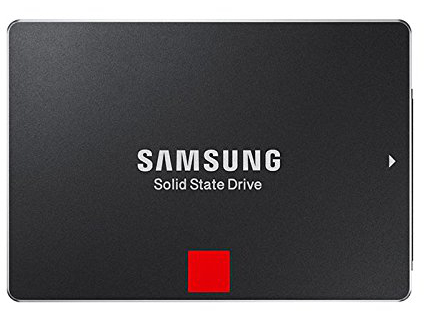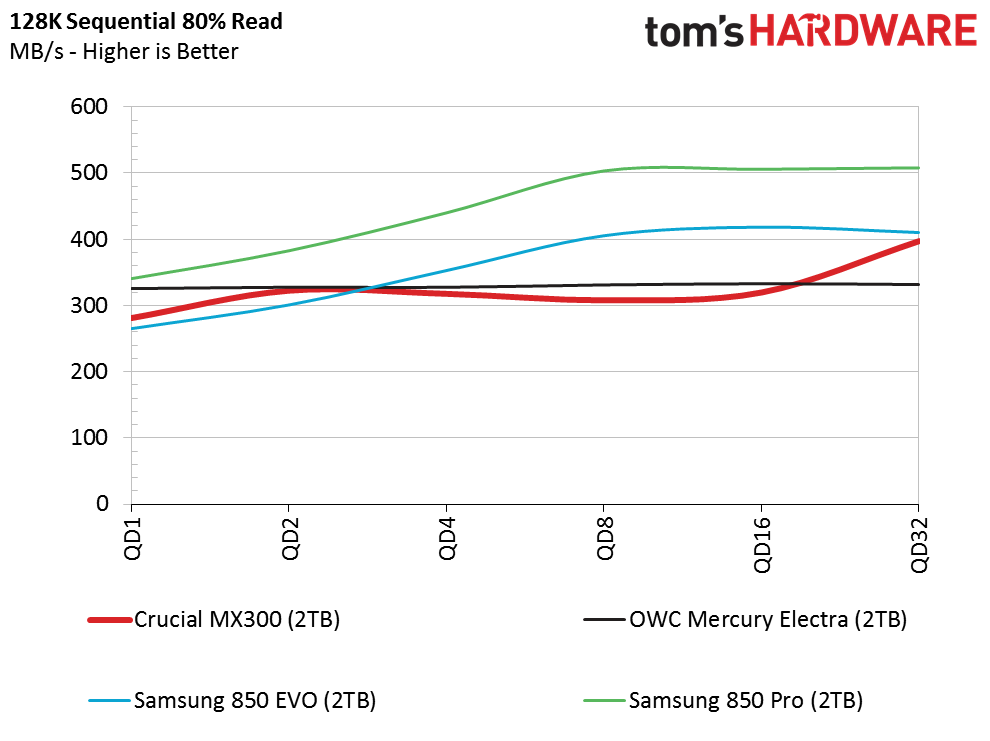Crucial MX300 2TB SSD Review
Why you can trust Tom's Hardware
Comparisons And Benchmarks
Comparison Products
There are currently only five consumer SSDs on the market with a 2TB capacity option. The Samsung 960 Pro is not included on the list due to the wide performance and price gap; the 850 EVO 2TB is the closest competitor to the MX300 2TB. Both products target the mainstream SSD market. The 850 Pro 2TB targets prosumer and enthusiast PC users, but it costs significantly more than the MX300. Finally, we have the OWC Mercury Electra 2TB that uses two 1TB SSDs pieced together behind a low-cost RAID controller, but it also retails for more than the MX300.
Sequential Read Performance
To read about our storage tests in-depth, please check out How We Test HDDs And SSDs. We cover four-corner testing on page six of our How We Test guide.

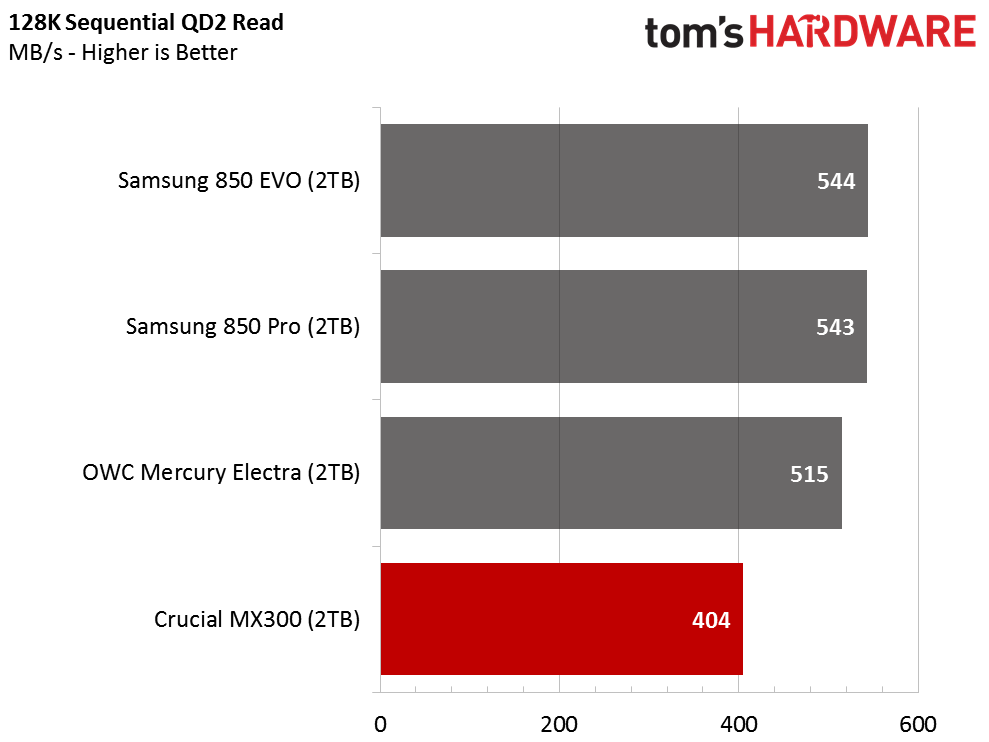
The Crucial MX300 2TB starts our tests in the hole with the three other 2TB consumer SSDs standing over it. It's reasonable to expect the two Samsung V-NAND products to perform better than the 4-channel MX300, but the pieced-together Mercury Electra 2TB scores over the MX300, which is unacceptable.
A 2TB SSD isn't the drive just for Word or other office documents. Most users keep data that takes up a lot of space, such as vast music and movie collections, on high-capacity drives. When you own and use a large capacity SSD most of the data is sequential in nature, which is easier for the SSD to work with than random data. The MX300 is one of the first modern SSDs that we've even had to make more than a passing comment about sequential read performance.
Sequential Write Performance


The MX300 performed much better during the sequential write test. In this test, the drive delivers nearly identical performance to the two Samsung 850 series products. Later in the review, we'll examine the sustained performance and steady-state drop-off.
Random Read Performance



You might have noticed that the two Samsung 850 SSDs are nearly identical on the line charts; it's very difficult to tell the two apart. The MX300 only trails the Samsung products by a small degree in our random read test (which scales up through the entire queue depth range). The MX300 trails all of the other products at Queue Depth 1, but 7,500 random read IOPS at QD1 is indicative of mainstream performance, which is how Crucial positions the MX300 on the market.
Random Write Performance


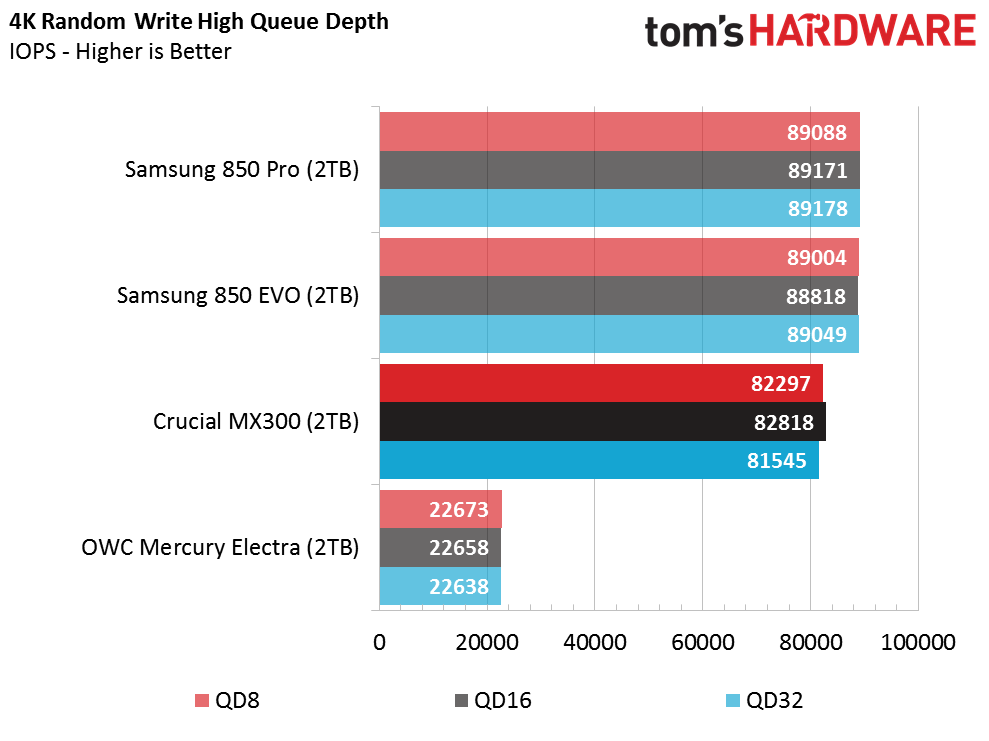
The MX300 didn't run into any issue with the random write workload. The difference between our test sample and the two Samsung 2TB products is negligible at low queue depths. You wouldn't notice the difference during normal consumer workloads.
Get Tom's Hardware's best news and in-depth reviews, straight to your inbox.
80 Percent Sequential Mixed Workload
We describe our mixed workload testing in detail here and describe our steady state tests here.
Moving on to mixed workloads, the MX300 2TB performs more in line with the OWC Mercury Electra 2TB than either of the two Samsung 850 products. This is one of the few tests where the two Samsung SSDs split with different levels of performance, but both show the same pattern of a gradual rise in performance as the queue depth increases. In contrast, the MX300 2TB has a slight increase at QD2 and then performance regresses until QD32, where it increases again.
80 Percent Random Mixed Workload
During mixed random workloads, the Crucial MX300 2TB exhibits a steady performance increase as the queue depth scales. The MX300 outperforms the 850 EVO 2TB At QD4, but at QD8 the EVO regains parity before it swooshes past the MX300 at very high queue depths.
Sequential Steady-State
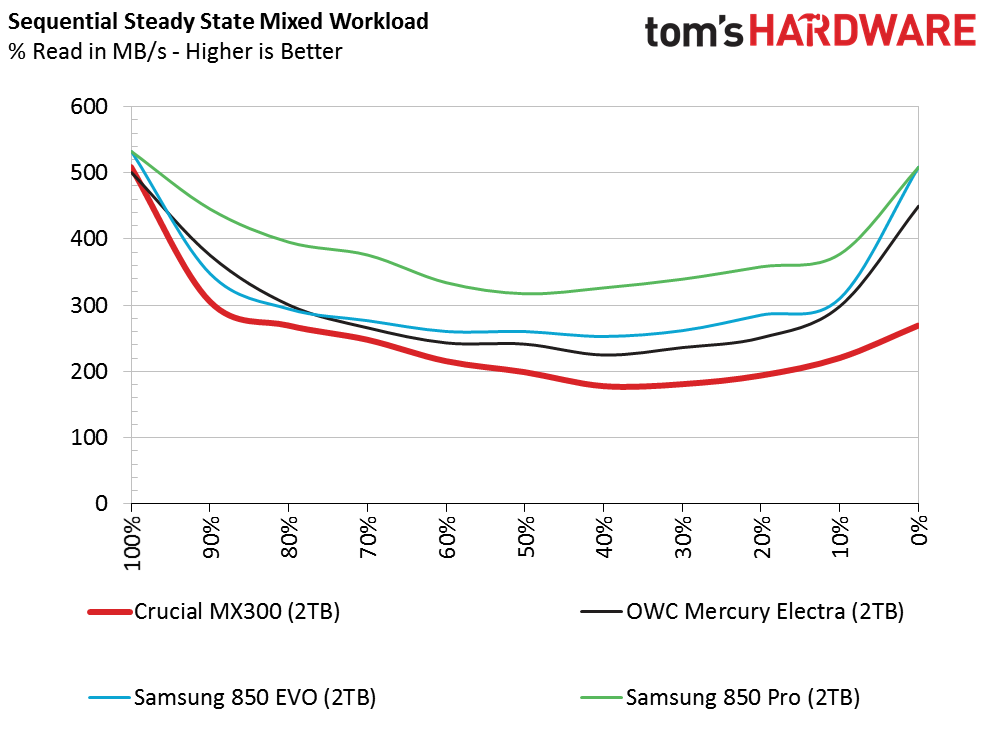


The sequential steady-state test shows the Crucial MX300 2TB and its Micron 384Gbit TLC NAND trailing the other products throughout the entire range of mixed workloads. This is a disturbing trend if you are looking to utilize the drive in a heavy use A/V editing machine with the mix down (an industry term for the converged final data file) going to an MX300 target drive.
Random Steady-State


Unlike the sequential steady-state tests, the MX300 places above the OWC Mercury Electra during the random steady state test. The Electra is basically a low-cost RAID controller that bridges two 1TB SSDs. The largest MX300 delivers the highest performance consistency of all the drives we've tested in the series. The random write IOPS are not very high (around 5,000), but they are more consistent than many of the other TLC-based products on the market.
PCMark 8 Real-World Software Performance
For details on our real-world software performance testing, please click here.
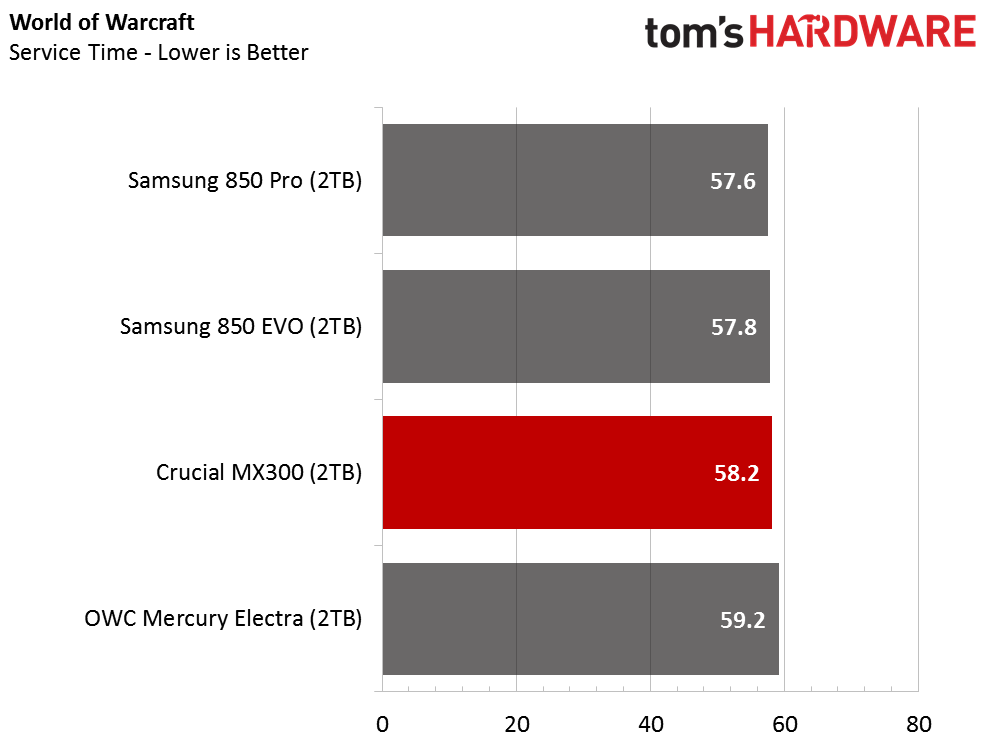






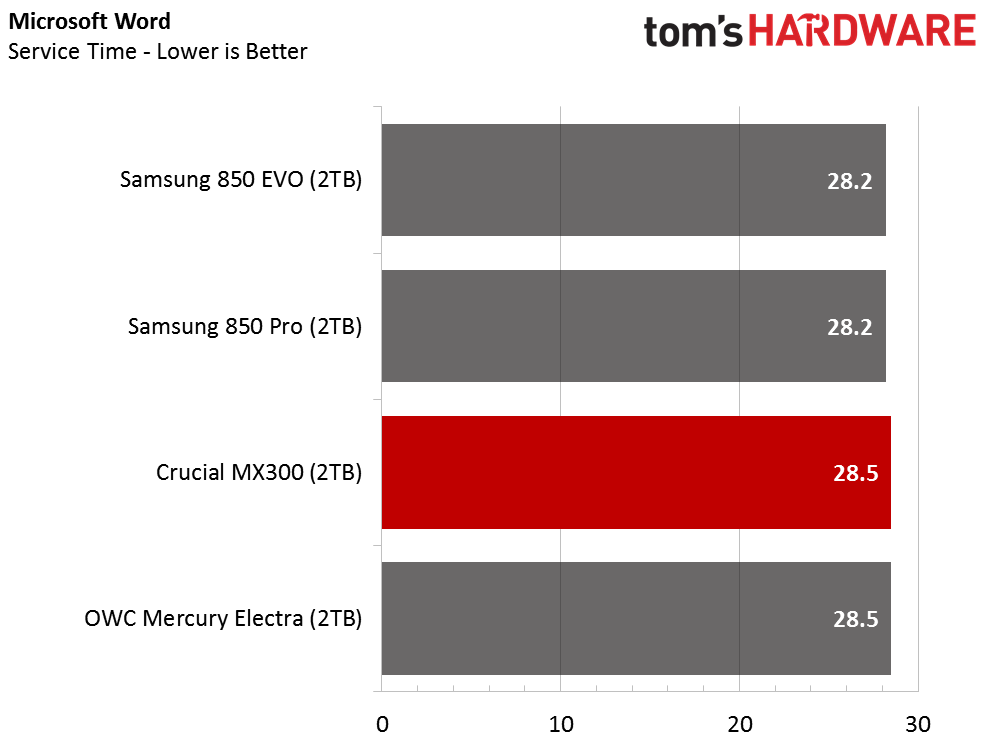


We are not surprised to find the two Samsung 850 Series products outperforming the MX300 2TB in real-world applications. You could say the same about the MX300 outperforming the Mercury Electra 2TB.
Application Storage Bandwidth
The MX300 2TB trailed the two Samsung SSDs throughout most of the individual tests. When we average the results and convert it to throughput, we see that a half a second (or more) per test adds up to a large aggregate performance gap. The difference between the MX300 2TB and the 850 Evo is roughly 72 MB/s.
PCMark 8 Advanced Workload Performance
To learn how we test advanced workload performance, please click here.



We've already discovered that the MX300 suffers during heavy workloads. The lower performance is due to the 3-bit per cell (TLC) NAND. What we haven't shown is how the drive recovers when it has ample idle time to clear the SLC buffer. The MX300 does recover after heavy use, but there is a large gap between the 850 EVO's recovery performance with Samsung's TurboWrite SLC buffer technology and the MX300's recovery with Crucial's SLC Dynamic Write Acceleration buffer. The 850 EVO is twice as fast as the MX300 at the end of the test, which is a full 150MB/s difference in performance.
Total Service Time



The service time test reveals a 2x difference between the 850 EVO and MX300. The service time measurement represents the worst-case scenario for the MX300, but the 850 EVO 2TB is faster across the board during the recovery stages. I, probably more than anyone, want Micron's TLC NAND to perform as well, or better than Samsung's V-NAND TLC.
Micron's 384Gbit NAND flash may be better than what we've seen, but we don't see parity with Samsung with the flash sitting behind a budget-minded 4-channel controller. Even the Intel 600p with the same flash, an NVMe front end, and a 6-channel configuration can't compete with Samsung.
Disk Busy Time
The disk busy time test shows us just how inconsistent the MX300 2TB is throughout the entire PCMark 8 Extended Storage Test, which Futuremark built on real-world software applications.
Notebook Battery Life


We added more SSDs in our notebook battery life test to get a better handle on what to expect from the MX300 series and other products. At 354 minutes of battery life on our Lenovo Y700 gaming notebook, the MX300 2TB delivers an average amount of battery life. We've tested many products in this system with the updated BAPCo MobileMark 2014.5 test, and most consumer SSDs fall between 340 and 360 minutes.
MORE: Best SSDs
MORE: Latest Storage News
MORE: Storage in the Forums

Chris Ramseyer was a senior contributing editor for Tom's Hardware. He tested and reviewed consumer storage.
-
xyriin The performance is a bit disappointing to say the least, but not unexpected. And while I like Micron NAND, I absolutely hate Crucial's Storage Executive software and their firmware updates.Reply
Looks like I'll be sticking with Samsung EVOs for my capacity needs at least in the near future. -
Game256 "We are currently in the middle of a NAND shortage due to the slower than expected transition to 3D NAND, new smartphones with increased capacity, and an assortment of flash-powered products coming to market. One company representative told me just days ago that, in his opinion, this is the worst shortage we've ever had."Reply
There is some wild shit happening with Samsung's 960 drives. Still zero information on 960 EVO. They moved the expected release dates multiple times on their site and finally stopped accepting pre-orders at all. -
elbert I wonder how 2 X 1TB's would do given they are cheaper than a single 2TB? I would like to see more drive and possible combo. I would want an M.2 960 EVO 512GB with the 1TB Crucial MX300 myself.Reply -
Rookie_MIB I'm actually ok with the performance figures listed because:Reply
1) It's reasonably priced. If they were pricing it like a 2TB Evo, no way. But at a $500 price range, that's not bad - about $0.25/GB.
2) It's got good capacity. My NAS is outfitted with 2TB drives - these could be replacements... although I'd need five of them. Hmmm.. Maybe not quite yet.
3) They're still MUCH faster and more reliable than HDDs.
It might not be a home run hit, but it's a solid double at least. -
mczak1 Kind of a pity Crucial doesn't offer the maximum capacity with 8 nand chips (albeit I don't know if the controller would support it), which would be 3GB. The 2GB version has 4 384GB chips (using 8 48GB dies each), 3 144GB ones and one 96GB one, you have to be kidding me... (fwiw the 525 and 1050GB versions use asymmetric configurations as well albeit noone seems to have noticed, 3 144GB / 1 96GB chip and twice the number of chips for the 1050GB version). Kind of interesting such asymmetric configurations don't seem to suffer from some weird performance anomalies...Reply -
mczak1 Reply
Errm that should have been 3 TB and 2TB above, of course...18850592 said:Kind of a pity Crucial doesn't offer the maximum capacity with 8 nand chips (albeit I don't know if the controller would support it), which would be 3GB. The 2GB version has 4 384GB chips (using 8 48GB dies each), 3 144GB ones and one 96GB one, you have to be kidding me... (fwiw the 525 and 1050GB versions use asymmetric configurations as well albeit noone seems to have noticed, 3 144GB / 1 96GB chip and twice the number of chips for the 1050GB version). Kind of interesting such asymmetric configurations don't seem to suffer from some weird performance anomalies... -
nukemaster I think it still ok for the price, The 850 evo is still much more costly in the stores i have access to.Reply -
Bruce427 ** There is some wild happening with Samsung's 960 drives. Still zero information on 960 EVO. They moved the expected release dates multiple times on their site and finally stopped accepting pre-orders at all. **Reply
I had planned to purchase three 960 EVO 500GB drives. But this "unknown" delivery date situation prompted me to go ahead and buy two NVMe drives of another brand.
Best-in-class performance is of little value if they can't deliver the drives.
At the very least, Samsung should update their customers on what is going on, and their new target release date(s).


